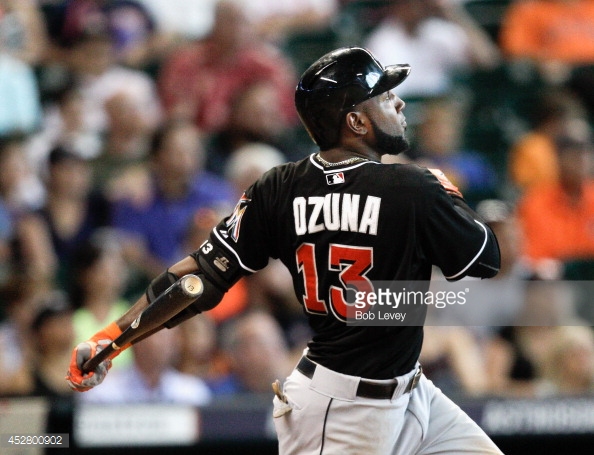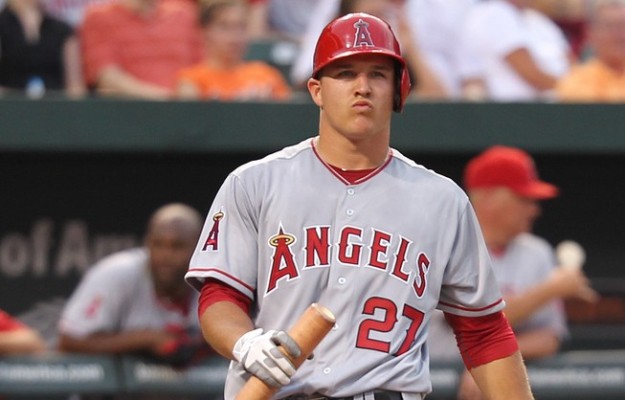2014 Fantasy Baseball: Revisiting Justin Upton
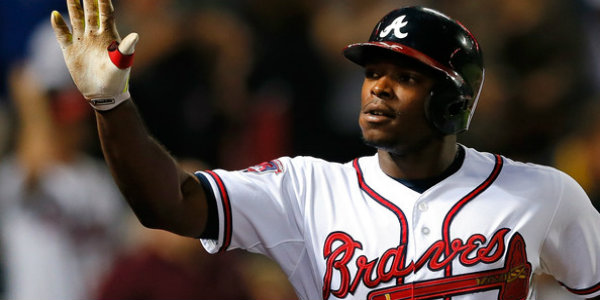

A few weeks ago, I wrote a piece about Justin Upton and his struggles with pitches up in the zone, fastballs in particular. The piece was published on a Friday. Upton, obviously wishing to make me look stupid, homered twice the night before the piece went live. It didn’t render the piece worthless, the numbers still told a story, but the timing was terrible. So today, I want to update you on Upton’s status.
Below, you’ll find a table, in which there are a few numbers (surprise!). The first row is populated with the numbers used in the original piece. The second row is comprised of his year-to-date totals.
| Justin Upton | BB% | K% | O-Contact% | Z-Contact% | Contact% | swSTR% |
|---|---|---|---|---|---|---|
| Original Article: 4/11 | 9.1% | 33.3% | 77.8% | 64.3% | 67.6% | 17.4% |
| 4/12 – 6/09 | 11.2% | 30.6% | 55.8% | 77.7% | 70.3% | 13.8% |
At the time of the original article, Justin Upton was swinging through pitches like it was his life’s mission. He’s improved some. He’s still swung and missed at more fastballs than anyone in baseball, except for his brother, but he’s swung and missed less since we last spoke. And that’s important because a 17% swinging strike rate is a lot different than a 14% one, even if it doesn’t seem like a huge difference.
I was worried I might come off as someone who was overly concerned with a small sample size. I was concerned about his early April performance (swings and misses; not counting stats, etc.) but I wasn’t really worried until I put the numbers in context with his career rates. Now we have a larger sample size, and thus, we can paint a clearer picture.[am4show have=’p3;p4;p7;p11;’ guest_error=’Front Office’ user_error=’Front Office’ ]
Upton’s been better since April 11, and that was to be expected. His contact numbers have completely flipped. Now, he’s making more contact in the zone while making less out of it, which makes sense, intuitively, and practically considering that contact on balls out of the zone usually doesn’t amount to much. His swinging strike rate is down, so his strikeout rate went down, too. A 30% strikeout rate isn’t ideal, but…improvement!
Upton’s calling card has always been his power, in fantasy and real life. His ISO, which currently sits at .259, is the highest it’s ever been. And despite his strikeout rate, he’s still hitting nearly .300. Upton’s still making less contact than he ever has, but he’s doing more damage when the ball is put into play. It’s an approach that has worked for many. It’s working right now for Houston’s George Springer.
My main concern in April was Upton’s struggles with pitches – specifically fastballs – up in the zone, especially considering his declining performance versus fastballs in general.
| Year | 4-Seam – AVG | 4-Seam – SLG | Sinker – AVG | Sinker – SLG |
|---|---|---|---|---|
| 2011 | 0.309 | 0.617 | 0.394 | 0.692 |
| 2012 | 0.262 | 0.384 | 0.354 | 0.620 |
| 2013 | 0.253 | 0.421 | 0.287 | 0.482 |
| 2014 | 0.263 | 0.540 | 0.354 | 0.500 |
Upton’s production versus fastballs has bounced back and fares much better when they’re down in the zone. He’s still coming up empty on a ton of the swings he takes at pitches up in the zone. I believe we can say, with some degree of confidence, that his swing has a hole or that his bat has slowed a little, perhaps both.
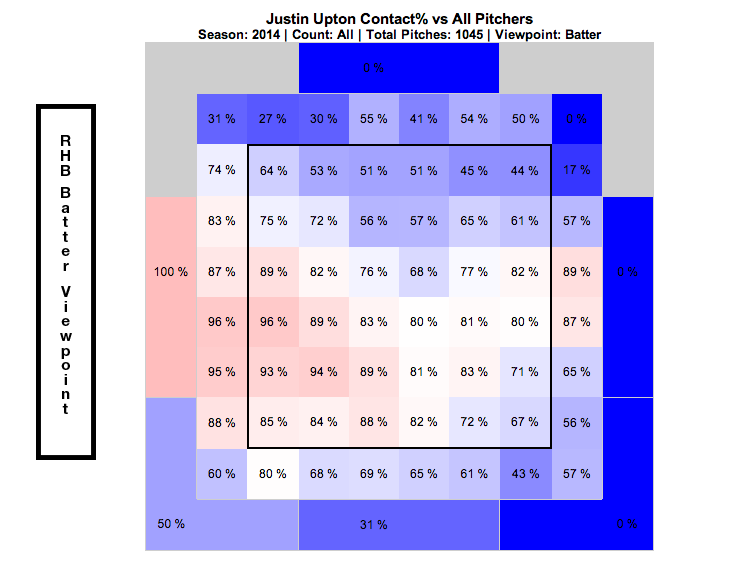
Fangraphs’ linear weights map backs up that assertion, perhaps more so than the contact map.
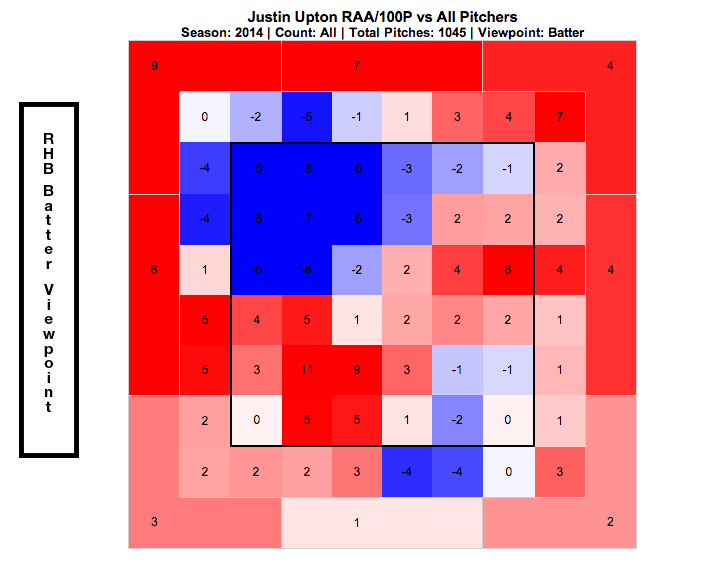
Every batter has a weakness, Upton’s is well known. So he should be seeing more pitches up in the zone, right?
You would think so, but he isn’t. He’s being pitched almost exactly the way he’s always been pitched, at least as far as location is concerned. He is seeing more fastballs than ever before – for the third year in a row – but they aren’t more frequently up in the zone than they used to be. Perhaps scouting reports haven’t completely caught up to him yet, but that seems like a stretch considering the constant assault of fastballs he’s under. I believe the answer is little more complicated than that.
Pitchers are trained throughout their careers to keep the ball down. Throwing up in the zone is equated with giving up 500 feet home runs, even if batters might actually fair a little worse up in the zone on average, from a power standpoint. Perhaps muscle memory and years of teaching are hard to shake off when facing a batter. In Upton’s case, his coldest zones happen to be where most pitchers aren’t comfortable spotting their pitches.
I still need and want to see more because a three year decline versus fastballs can’t be completely undone with two and a half months of good work, but it seems like Upton has righted the ship a little. Most hitters have holes in their swing. Perhaps, especially in Upton’s case, holes don’t matter quite so much when a hitter is able to punish balls in the parts of the zone in which pitchers throw the majority of their pitches.
Upton’s transformation as a hitter has been interesting to watch. In 2011, he combined power with good contact rates. Then, he struggled a little with both, despite his high home run total in 2013. Finally, in 2014, his power is being shown at career high levels and he’s hitting for average, despite posting the highest strikeout rate of his career.
Baseball, man. It’s a beautiful game that sometimes just doesn’t make any sense. Justin Upton’s road from struggles to flourishing is just more proof that, in sports, especially baseball, there are multiple ways to be successful. At this point, Upton’s become a bonafide three true outcome player – 46% of his plate appearances end in a walk, strikeout, or dinger; the seventh highest rate in the majors among qualified hitters. It’s hard to argue with the results he’s achieved. Your fantasy team probably doesn’t mind the changes, either.
[/am4show]


